The Eternal Ache (2023) is a very chaotic abstract work in which oils are layered on top of each other. The claw marks in the top left corner create tension as though the painting has been scratched – perhaps as understanding that the work is related to anxiety; this could be that these scratches are invading the consciousness. The three ‘nervous’ nebulae, red, blue and black (or brown), explode through the canvas but are held back by the black swirling border. The red and black nebula seem to overwhelm the blue nebula, suggesting that thoughts, anxieties and trepidations surround the conscious.
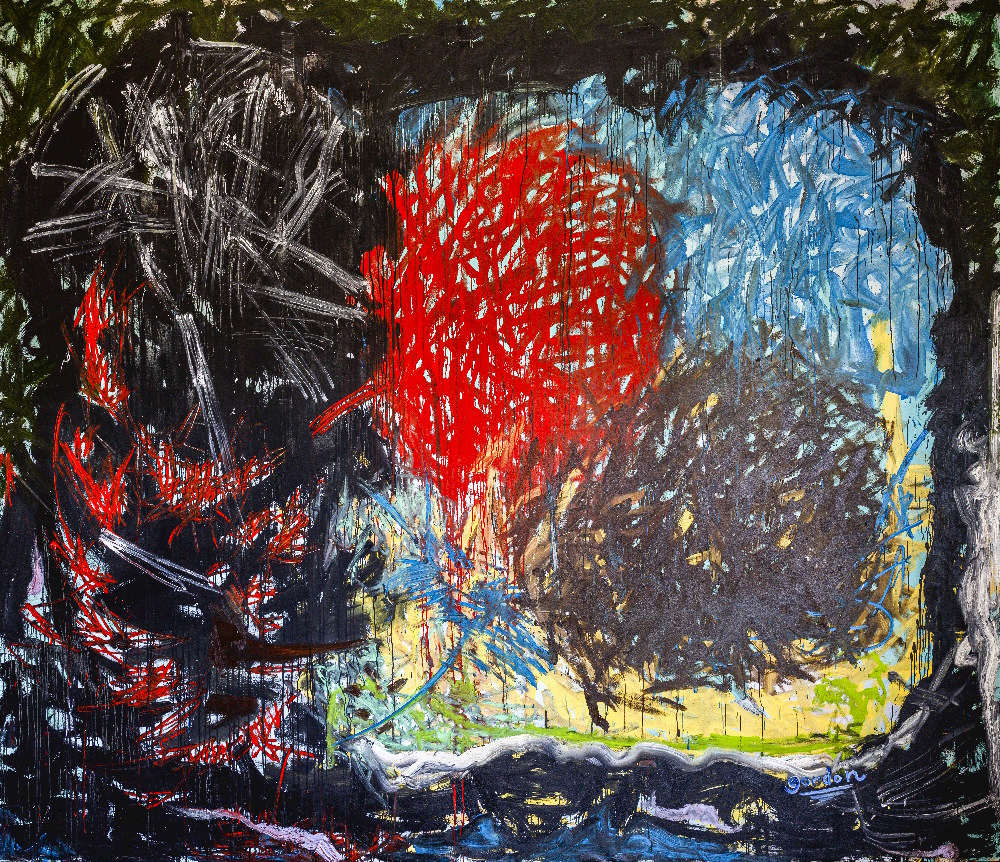
The black border confines these emotions and locks them in; perhaps the claw marks are an attempt to break out of this- however, as much as the marks attempt- the border does not shift. Thus, it creates a sense of entrapment as the painting is confined to these anxieties and pains and cannot escape. Hence, the painting impounds itself onto the viewer and the viewer can directly translate these elements into impending anxiety, achieving this ‘catharsis’. This allows the viewer to immerse themselves in this anxiety and chaotic scene and reflect on their anxieties – which we all have.
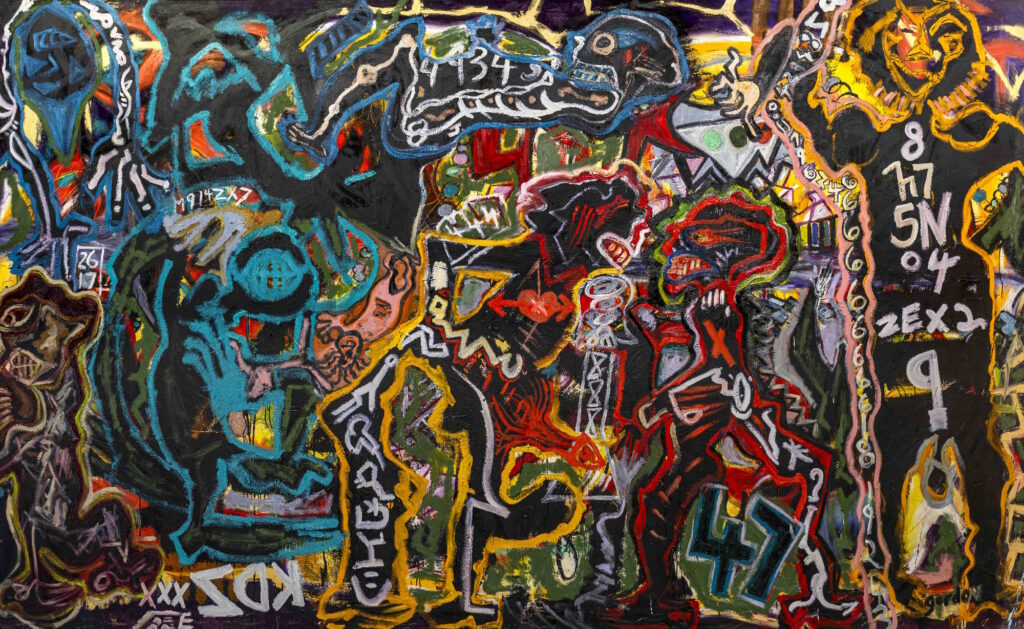
Two Monsters and Their KDZ (2024) explores trauma and resilience. Massman uses a gestural technique to create the figures in the painting, with jagged outlines, dense textures and contrasting colours that create a chaotic but engaging scene. The artwork’s title invites viewers to navigate the story, where monstrous figures surround the two children. Therefore, it stresses the disproportionate power dynamics reflecting Massman’s focus on the scars left by narcissistic or abusive parental figures.
Despite how they are treated, the children have endured these hardships and emerged as compassionate adults. This gives the work a redemptive narrative and helps to give the chaotic imagery some hope that it gets better. Hence, the painting’s story is not only the trauma which terrible parents cause but also the survival of this trauma and even perhaps the downfall of the parents as the children have risen above them.
The fragmented shapes and jagged lines surrounding the painting create a form of mental fragmentation while the bursts of red or yellow perhaps are moments of violence or danger. The monstrous figures, mentioned earlier, are represented in a grotesquely abstracted form- which perhaps are the parents – seem to oppress the two children.
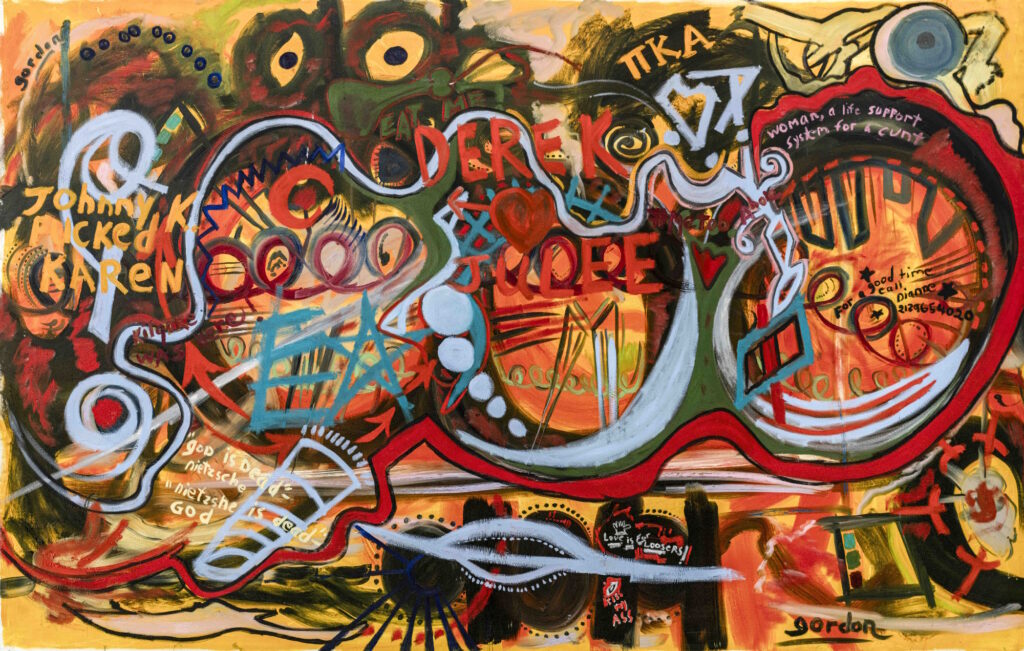
Messages from a Lavatory (2022) is a bold graffiti-style artwork sprawling with text, symbols and shapes in a very chaotic way. The colours contrast and clash, replicating the graffiti of a public lavatory wall, from which we can see that it has been layered with graffiti, covering each part. Due to the painting’s incredibly packed elements, we are invited to look much closer and inspect every part for its details.
As the title transports the viewer into the scene in which it takes place, Massman’s description of the graffiti as ‘ugly and largely misogynistic’ helps to give context to the artwork as it is both documentative and a critique of societal cruelty and misogyny. Thus, the artwork is also critical towards the society of that time and how humanity was crueller in that era.
The fragmented text across the artwork is repetitively misogynistic, especially with the “Johnny K Fucked Karen”, “For a good time call Dianne,” and “woman, a life support system for a cunt”. This repetition shows the misogyny of the past (and present, as this still happens to this day) alongside the cruelty of such words and brutality. The artwork’s chaotic composition and abrasive subject matter create discomfort as they force the viewer to confront the ugly aspects of humanity.
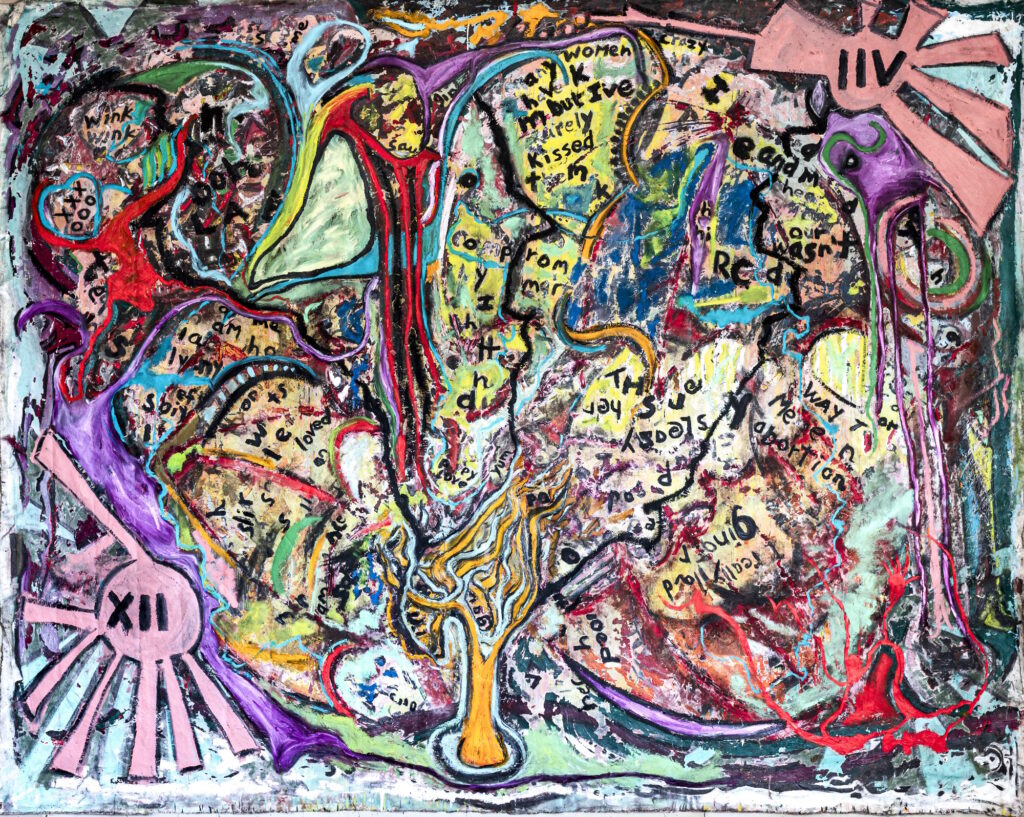
One on Three (2024) is an oil painting with extraordinary depth, filled with many layers, images, phrases and textures. The scraping and sanding of the earlier layers results in a more textured surface, as the past layers are now visible beneath the new ones. The technique seems to embody creation, as the strokes, vibrant colours, and text are applied like in a trance, making it feel as though the painting is alive through its intensity.
The work’s title explores the complexity of romantic relationships of idealised and experienced love. The phrases: “wink wink” and “we loved” along with the fragments of texts across the canvas becomes a map of emotions- between the highs and lows of romance. The work is not a romanticised portrayal of love but rather an exploration of love’s contradictions. Love is imperfect. It is depicted as layered, scraped and sanded down, revealing the truth behind the polished surface.
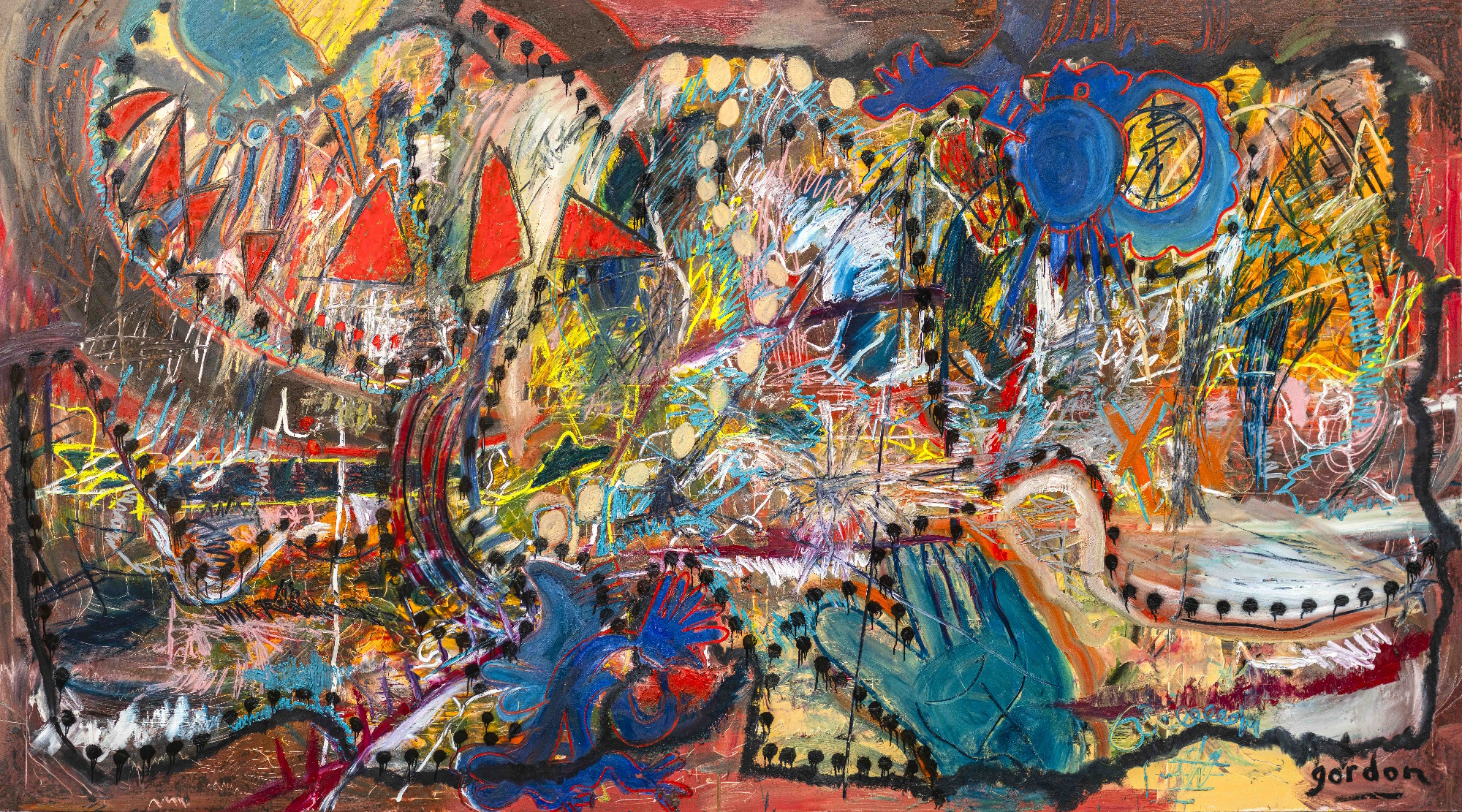
The Disturbed Child’s Playroom Wall takes the viewer into the chaos of the interior. The painting seems as though it envelops the viewer and closes in on them as though it’s coming alive. The colours, fragmentations, and disarray create an anxious atmosphere in the work, while the scratches make it feel like they are taking over the viewer’s mind.
The work’s texture is uneven, as though the painting is subjected to the torment of the playroom that it represents- in which these elements make it seem as though the viewer has been confined to this space. This creates an engagement with mental illness, societal neglect and the familial shame that the child is going through. The painting seems to be as though it is a cry for help, as is evident through the marks, scratches, and general composition.
The implied backstory of the child, who is confined to the attic or top-floor bedroom and deemed an embarrassment by her family, turns the work into a tragedy. It is as though the painting is an invitation into the scars inflicted by narcissistic, abusive and uncaring parents. Thus, we are to experience the inner thoughts of one who has been misunderstood, neglected and marginalised, and the painting thus overwhelms the viewer with pain and anxiety.
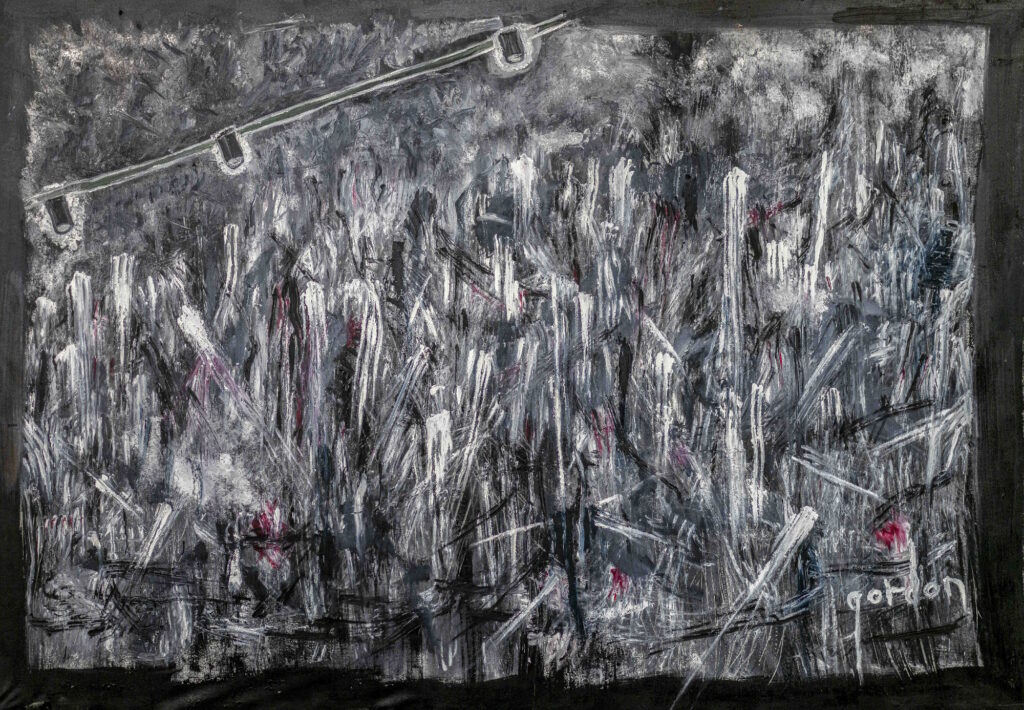
The Wall They Clawed (2023) has captured the crimes and horrors of the Holocaust with anguish and intensity. The painting is mostly black and white with the occasional red which look like gunshots or perhaps are symbolic of Massman’s torn fingernails and bloodied knuckles from the creation of the work and are remnants of this. The red itself, however, does seem to suggest the blood and the human cost of the atrocities of the Holocaust.
The work’s texture is extremely layered- the scratches, scrapes and claws on the surface mirror the title, an act of desperation. The upper left corner (and slightly the middle) symbolises the canisters of Zyklon gas. The canisters are much more simplistic compared to the more chaotic and violent markings below- these elements bring the viewer to confront the inhumanity of genocide and its consequences on humanity.
The wall, which mentioned in its description as being taken after the liberation of Auschwitz, has become a metaphor for the suffering of the concentration camp’s victims. The artwork brings the viewer to contemplate on the desperation and helplessness brought about by human cruelty and to remind the viewer that this should never happen again.

Humans Melting Left to Right (2024) engages with the disintegration of humanity as fascism overtakes liberal democracy. The large-scale work looks like it unfolds in three stories from the left to the right. The red bleeds into the yellows, blues and browns of the three compositions, symbolising humanity melting. The drips from the central area (which looks like a wound within the three sections) look like they are actively decaying before the viewer’s eyes.
The left region of the painting is mostly composed of vibrancy: yellows and reds, which seem to suggest liberal democracy, and a bright society which slowly turns towards the centre, where it has now become fragmented and chaotic. This then further decays into the right, where it starts to become blue and grey and descends into further chaos and despair.
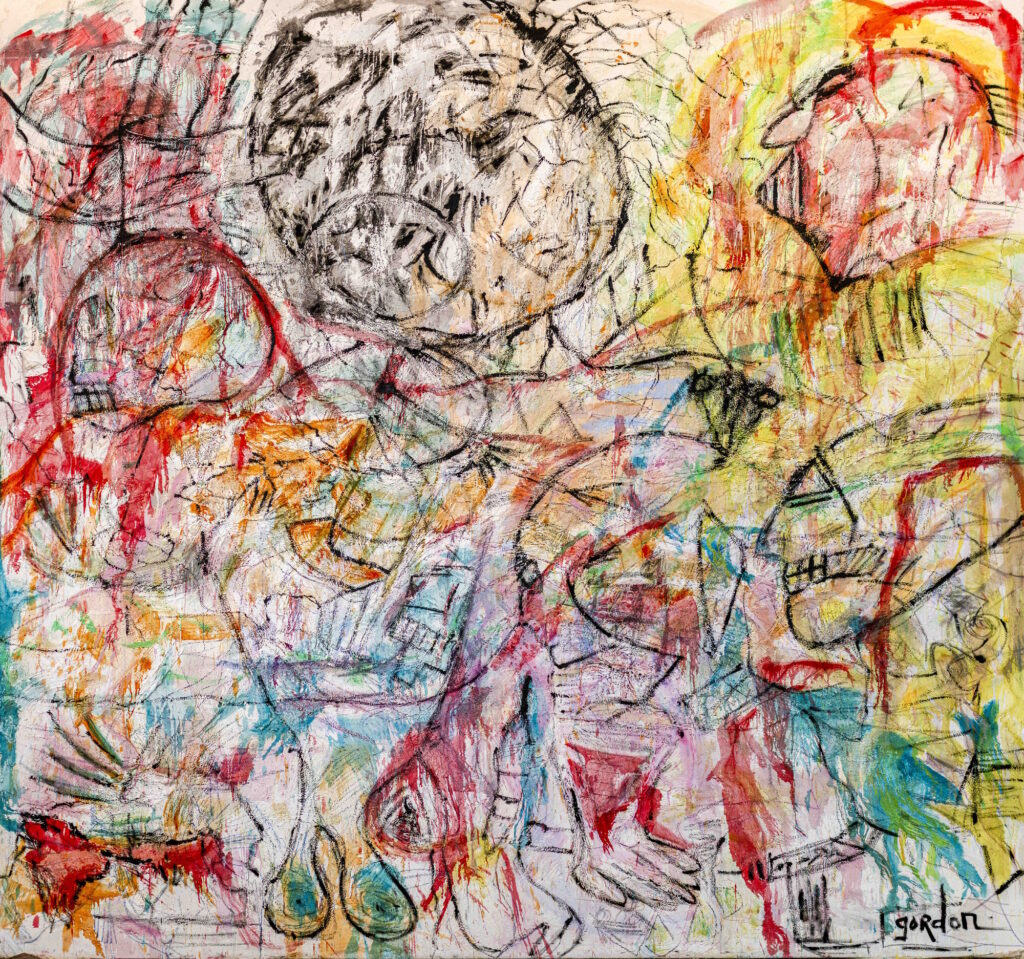
The Dubious Angel (2024) shows an angel who has been tasked to save humanity; however- this angel is not depicted as a triumphant or angelic figure but rather as a doubtful and failing angel. The composition captures this as the ghostly faces remind the angel of its failure while also expressing sorrow, anger and despair. The painting seems to imply that this saving is unresolved, and swirling frenetic lines create chaos and make it seem as though this task is futile while the ghosts continue to haunt the angel.
Thus, we can see and examine from the painting that it shows the complexity of intervention, as even the divine cannot save humanity from self-destruction. The red smearings and drips seem to showcase the sacrifice and blood, which could imply that the angel’s attempt is only furthering humanity’s self-destruction. Viewers are thus invited to engage with the painting to decipher human failure, reflect on how humanity has come so far in destroying itself, and contemplate humanity as a whole.
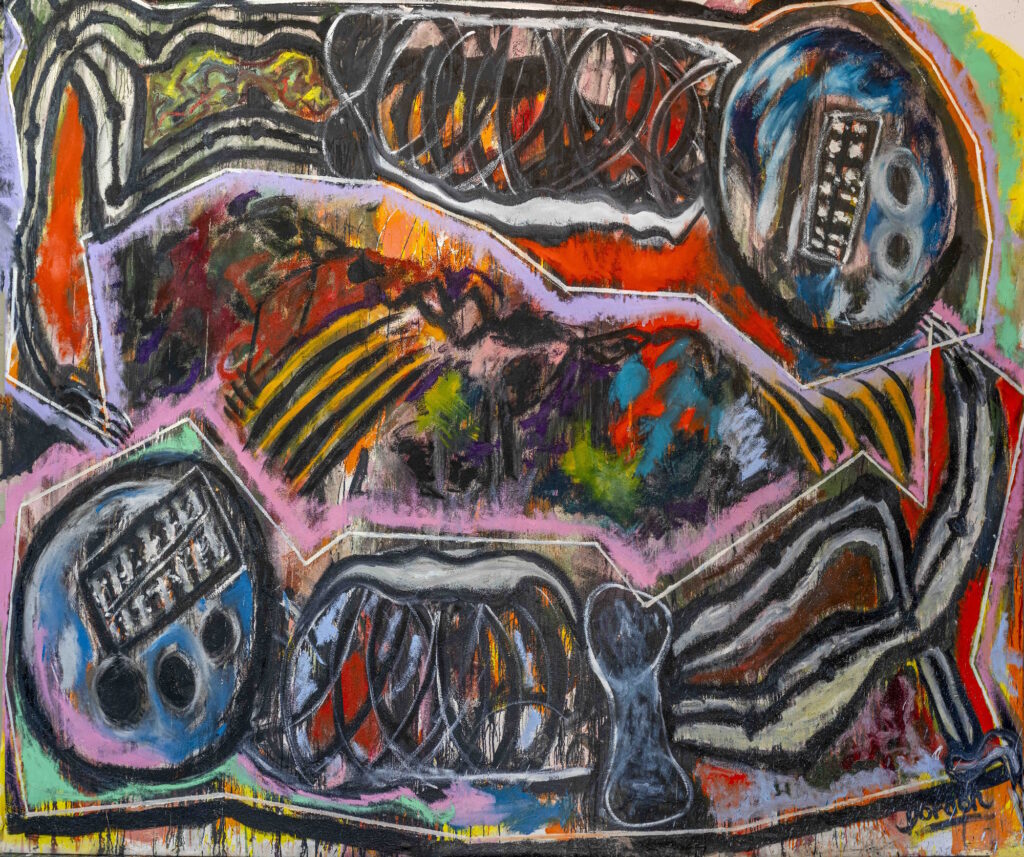
The End of a Great Marriage (2024) presents two skeletons connected while surrounding them with more vibrant and slightly chaotic abstract placements of colour. The artwork seems to celebrate the lives of the two individuals. However, it doesn’t idealize the relationship as it acknowledges the good and bad of their experiences together in their marriage. The way the two skeletons are positioned (in which they are atop each other in a circular shape) highlights the unity that they have had together.
The vibrancy of the composition locks the viewer into place as they explore the canvas. The colours—red, which could imply the love and passion of the relationship—are contrasted by blue and purple, which are perhaps (with blue) the downs and purple, a more reflective and harmonious approach to the relationship. Yet, the loss of both of them allows the viewer to contemplate their own relationships and the legacies that they leave behind.
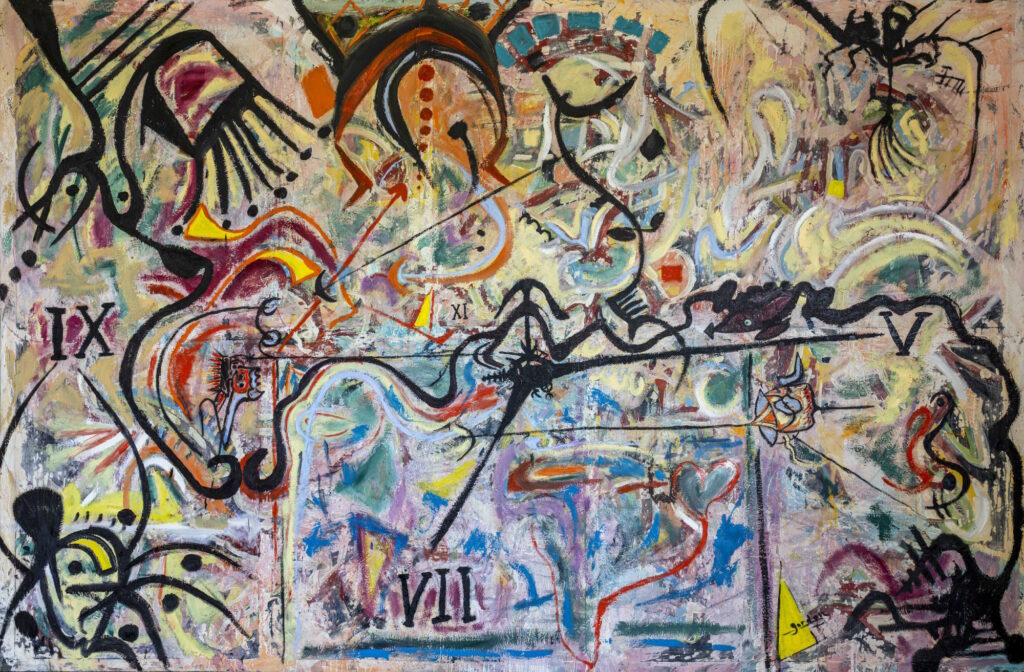
Orbiting Nepture (2024) brings viewers in through its dark, moving hands that guide us through the painting. In which we are journeying outer space and the subconscious (with which Neptune is often associated)- the clock hands and the Roman numerals make it feel as though it could potentially be a memory. Or, perhaps, we are moving through memories, which suggests that the painting is a lived experience.
This journey embeds these memories and encourages them to explore their memories. The strange creatures around the canvas, which seem to be octopus-like creatures, reinforce the subconscious and the dreaming within the work. The numerals present and suggest tension between time and the eternal which gives it an existentialistic theme. Hence, it takes the viewer and challenges them to explore their own existentialism within this exploration of the subconscious.
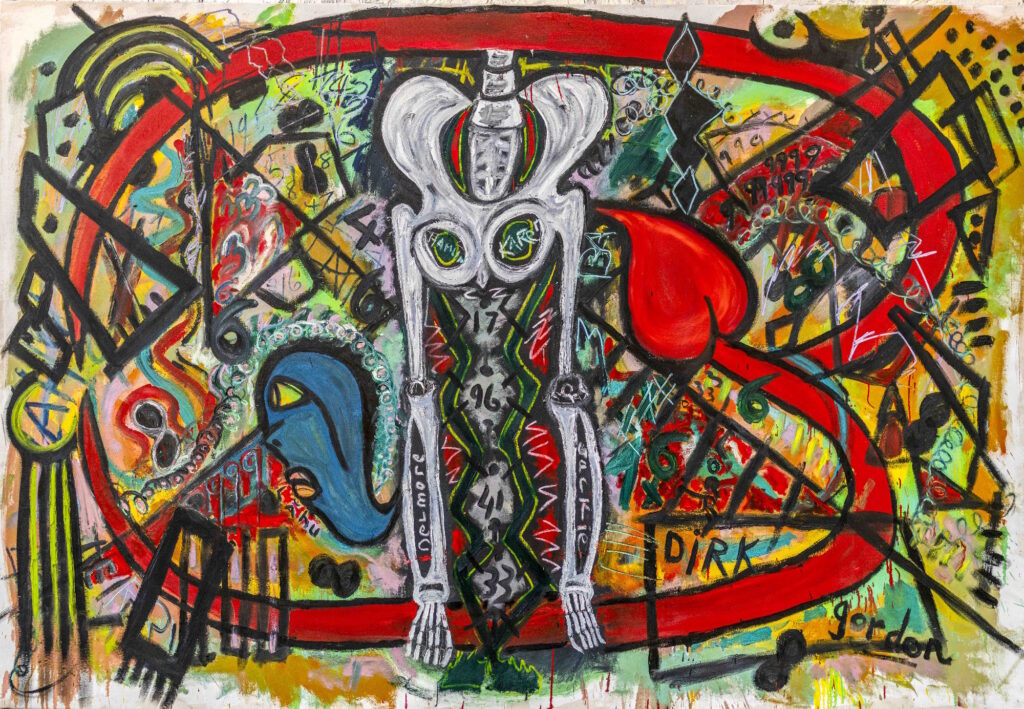
Jackie Boy Steps Out on Planet Earth (2023) shines with its vividity and spontaneity where the figure of “Jackie Boy” is centered within the composition and the elements surrounding him guide the viewers eye back toward him. Jackie Boy is described as “everyman born without consent” which reflects the journey of humanity exploring existence which can sometimes be overwhelming. The figure is skeletal which shows this existentialism and his fragility. The posture is upright which suggests him to be brave but uncertain of what happens next. Consequently, the environment surrounding him is wildly chaotic and this reflects life and the universe.
The heart that seems to encircle around him and draws the viewer towards him seems to reinforce the idea that he is searching for meaning in the middle of this existential crisis and chaos.
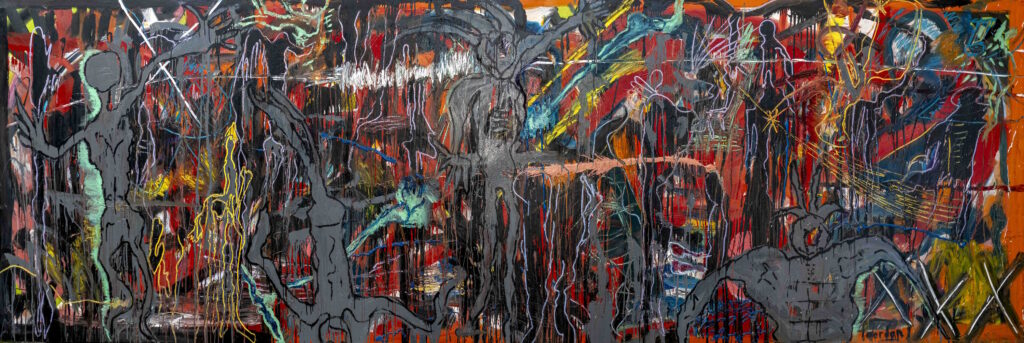
The Dancers (2024) is composed of elongated abstracted human forms distributed in an environment of fiery reds, yellows, blues, and blacks. The dancers are slightly hidden or obscured and merge into the surroundings, which implies that they are becoming the crowd and encouraging more ecstasy. The figures seemingly move rhythmically throughout this fiery environment, highlighting their joy and abandonment. The dancers are dancing in a communal experience, which helps them forget about pain and reconnect with their happiness.
The chaotic background against these fragmented forms also could represent how life is challenging, and these dancers are attempting to enjoy life rather than live through those turmoils. They embrace chaos to gain joy from it. The contrasts between the figures and the background help to imply that they are both individual yet emphasize how they are immersed in the crowd and chaos. This, therefore, brings forward that they are struggling- but they abandon that in the dance for liberation.
